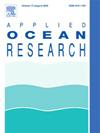Accelerating coral rubble instability assessments with machine learning: insights from the Great Barrier Reef
IF 4.3
2区 工程技术
Q1 ENGINEERING, OCEAN
引用次数: 0
Abstract
The stability of coral rubble is crucial for coral reef recovery since a stable coral rubble base is essential for coral regeneration. To enhance the effectiveness of coral reef restoration and to model the recovery and connectivity of coral reef ecosystems, it is crucial to predict coral rubble stability over extensive areas and long timeframes. The assessment of rubble instability on individual small-scale coral reefs can be calculated using physical-based models. However, these models are time consuming, limiting their ability to predict coral rubble instability over large spatial scales with high resolution. Here, the Random Forest machine learning algorithm is used to efficiently process large databases containing information on coral reef hydrodynamics and related coral rubble instability and provide estimates on the importance of specific variables in the classification of rubble as stable or unstable. Adopting a Random Forest model provides a significant advantage in addressing the non-linear problems inherent in risk assessment and significantly reducing the model calculation time. In this study, physics-based and Random Forest-based assessment models were adopted to evaluate coral rubble instability risk across the Great Barrier Reef (GBR), with the performance of the trained Random Forest model evaluated against the physics-based model. Seven hydrodynamic characteristics were selected, and 1.2 million physics-based model samples were utilised in the Random Forest model for training (70 %), validation (20 %) and testing (10 %). These samples include the southern, central, and northern reef areas of the Great Barrier Reef, ensuring that the model is comprehensively trained and capable of producing more accurate and reasonable prediction results. Results show that the Random Forest model reduces the prediction time by several order of magnitude compared to the physics-based model: assessing rubble instability in the entire GBR takes only two minutes with the Random Forest model. Additionally, the trained Random Forest model eliminates the resolution limitation: it can rapidly assess new cases irrespective of data resolution changes, without the need for recalculations, unlike physics-based models. Moreover, the Random Forest model enables broader application for assessing coral rubble instability beyond just the GBR. This is because the Random Forest model only requires relevant key factor data to assess coral rubble instability. Among all seven factors, mean depth has the greatest impact on the prediction results, with a Gini decrease index of 34 %. The Gini decrease index measures the importance of a factor by indicating how much it decreases the impurity in the data split; a higher value means greater importance. Other factors have indices around 10 %. Therefore, even in regions with limited data, rubble instability can be effectively assessed with only depth measurements and wave climate information. This study demonstrates a novel and highly successful approach to predicting rubble instability on large scales, offering value guidance for coral reef recovery efforts in the GBR and significantly reducing the required field-based data.
用机器学习加速珊瑚碎石不稳定性评估:来自大堡礁的见解
珊瑚碎石的稳定性对珊瑚礁的恢复至关重要,因为稳定的珊瑚碎石基础对珊瑚的再生至关重要。为了提高珊瑚礁恢复的有效性,并模拟珊瑚礁生态系统的恢复和连通性,在大范围和长时间框架内预测珊瑚碎石的稳定性至关重要。对单个小型珊瑚礁的碎石不稳定性评估可以使用基于物理的模型进行计算。然而,这些模型耗时,限制了它们在大空间尺度上以高分辨率预测珊瑚碎石不稳定性的能力。在这里,随机森林机器学习算法被用来有效地处理包含珊瑚礁流体动力学和相关珊瑚碎石不稳定性信息的大型数据库,并提供对碎石稳定或不稳定分类中特定变量重要性的估计。采用随机森林模型在解决风险评估中固有的非线性问题和显著缩短模型计算时间方面具有显著优势。本研究采用基于物理和基于随机森林的评估模型对大堡礁(GBR)的珊瑚碎石不稳定风险进行评估,并将训练后的随机森林模型与基于物理的模型进行比较。选择了7个水动力特性,并在随机森林模型中使用120万个基于物理的模型样本进行训练(70%)、验证(20%)和测试(10%)。这些样本包括大堡礁的南部、中部和北部珊瑚礁区域,确保模型得到全面的训练,能够产生更准确合理的预测结果。结果表明,与基于物理的模型相比,随机森林模型将预测时间缩短了几个数量级:使用随机森林模型评估整个GBR的碎石不稳定性只需两分钟。此外,经过训练的随机森林模型消除了分辨率限制:与基于物理的模型不同,无论数据分辨率如何变化,它都可以快速评估新情况,而不需要重新计算。此外,随机森林模型可以更广泛地应用于评估珊瑚碎石不稳定性,而不仅仅是GBR。这是因为随机森林模型只需要相关的关键因素数据来评估珊瑚碎石的不稳定性。在7个因素中,平均深度对预测结果的影响最大,其基尼系数下降指数为34%。基尼下降指数通过表明一个因素在数据分割中减少杂质的程度来衡量它的重要性;数值越高意味着越重要。其他因素的指数在10%左右。因此,即使在数据有限的地区,仅凭深度测量和波浪气候信息也可以有效地评估碎石的不稳定性。该研究展示了一种在大尺度上预测碎石不稳定性的新颖且非常成功的方法,为GBR中的珊瑚礁恢复工作提供了有价值的指导,并显着减少了所需的现场数据。
本文章由计算机程序翻译,如有差异,请以英文原文为准。
求助全文
约1分钟内获得全文
求助全文
来源期刊

Applied Ocean Research
地学-工程:大洋
CiteScore
8.70
自引率
7.00%
发文量
316
审稿时长
59 days
期刊介绍:
The aim of Applied Ocean Research is to encourage the submission of papers that advance the state of knowledge in a range of topics relevant to ocean engineering.
 求助内容:
求助内容: 应助结果提醒方式:
应助结果提醒方式:


